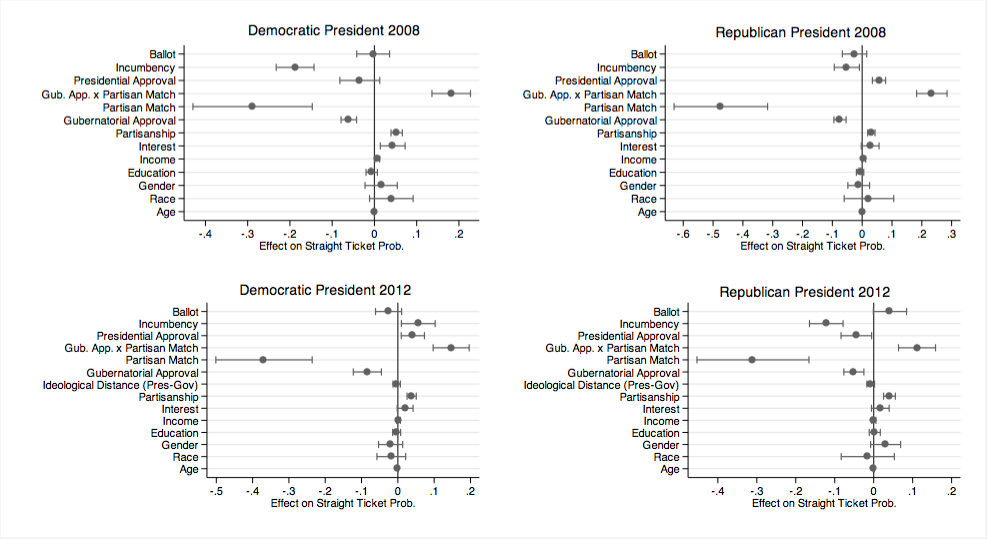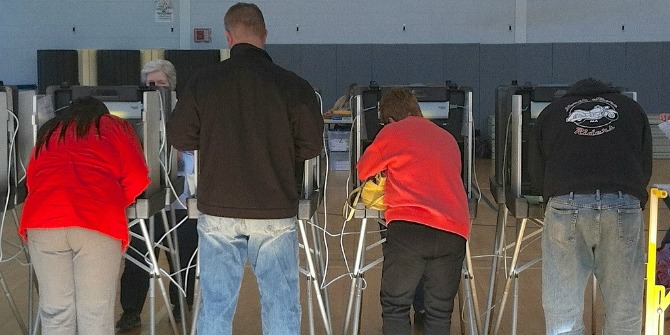
 The US is not just electing a new president in 2016 – in 12 states voters will also be able to choose their next governor. In new research, Amuitz Garmendia Madariaga and H. Ege Ozen examine how presidential and gubernatorial candidates’ electoral fortunes are intertwined. They find that voters are more likely to cast a straight ticket ballots in presidential election years, and that successful gubernatorial candidates actually provide a vote boost for presidential candidates at the state level, not the other way around.
The US is not just electing a new president in 2016 – in 12 states voters will also be able to choose their next governor. In new research, Amuitz Garmendia Madariaga and H. Ege Ozen examine how presidential and gubernatorial candidates’ electoral fortunes are intertwined. They find that voters are more likely to cast a straight ticket ballots in presidential election years, and that successful gubernatorial candidates actually provide a vote boost for presidential candidates at the state level, not the other way around.
Multilevel structures of government are spreading all around the world but we still know little about the relationships between tiers of subnational, national and supranational institutions. In new research we analyse how and to what extent the federal structure in the United States is taken into account by individual voters and the voting population as a whole. Given the unfolding 2016 presidential election, this is a topic worth exploring. We find that while those running for governor during presidential election years gain no benefits from presidential candidates from the same party, presidential candidates do gain more votes in states where gubernatorial candidates from their party are successful.
In our research, we depart from the normative idea of the role of integrated parties in federations to test for what we think is its logical electoral expectation: the existence of reciprocal electoral spillover effects between candidates of the same party across different levels of elections happening at the same time. In the context of American federal institutions, integrated parties are understood to assure the survival and success of co-partisans by coordinating the incentives of local and national elites. As a result, by assuming party candidates across different levels of elections are dependent on one another, these organizations serve as long-term electoral coalitions which discourage conflict within the party. Interestingly, our main expectation is also in line with most recent work on the study of coattails in the US, which show that if voters use basic heuristics to make their choices in American elections, spillover effects should happen both up and down the ballot depending on how much information is available.
Our focus is on simultaneous gubernatorial and presidential elections in the US To that end, we use – as a motivational starting point – the change that a majority of states has experienced in their gubernatorial election years since 1950s. Nowadays, only eleven of a possible fifty gubernatorial races are held on the first Tuesday in November during presidential election years. The rest have been gradually moved to off-year elections as Figure 1 shows. This institutional change was largely motivated by the idea that governors were supposedly riding the so-called ‘coattails’ of their own party’s presidential candidate. According to this logic, races for the governorship would be dominated by, either, heightened partisan divisions or the importance of national issues rather than by issues specific to a given state. Yet, not all states have moved their gubernatorial elections to off-years, and this gave us a chance to see whether the concerns about presidential coattails were legitimate or not, as well as to analyse the possible existence of reverse coattails (presidents performing well in a state in line with successful gubernatorial candidates).
Figure 1 – Evolution of gubernatorial election years

For the intertwined incentives of co-partisans to matter at the polls, voters should first be able to recognize the benefits of having the same party candidates holding executive offices at different territorial levels; this is what we first analyse at the individual level. We use on-year survey data to understand the main factors that explain voters’ decision to cast a straight or a split ticket, especially when considering scores of presidential and gubernatorial candidates about whom they have varying levels of information (we also show how and why is split ticket voting more pervasive during off-year elections). Our results find that, other things being equal, voters base their decisions on simple cues: partisanship and evaluation of performance. As Figure 2 shows, as voters’ partisan attachment and the approval of their party’s presidential and gubernatorial representatives increases, the probability of casting a straight ticket increases as well.
Figure 2 – The effect of individual and state level characteristics on straight ticket voting

Note: The DV is taken from the CCES survey questions on presidential and gubernatorial vote choices. Voters who cast a straight ballot are coded ‘1’ while voters who cast ballots for candidates from different parties are coded ‘0’
Our results confirm that Democratic presidential voters who expressed higher levels of pre-election approval for President Bush in 2008 were less likely to cast straight tickets (and vice versa). Candidates’ incumbency appears to be an important impediment in this regard; the available information about incumbents reduces voters’ need to rely upon other cues (as party label) significantly decreasing the probability of straight ticket voting.
Our next step is to track such a voting pattern in the aggregate by accounting for the so-called ‘two-sided’ coattail effects between same party presidential and gubernatorial candidates. Traditionally, it has been understood that the high importance of presidential campaigns provides readily accessible information about candidates to voters that affect decisions down the ballot, whichever the office. Yet, we think that these coattails are more or less effective depending on the nature of gubernatorial race competition. What we argue is that presidential election outcomes could also be influenced, at the state level, by the presence of particularly strong (or weak) gubernatorial candidates; and this should be true even after controlling for candidates’ campaign spending and incumbent status.
We focus our analysis on those 26 states that since 1960 have had, at least, one of their gubernatorial elections in presidential election year. Since we are looking for a relationship between presidential and gubernatorial election outcomes which goes both ways, we estimate the reciprocal effect of two linked variables: the vote percentage of a presidential candidate at the state level and the vote percentage of the same party state executive candidate.
Paradoxically, and contrary to the previously mentioned reasoning behind the process of separating state executive elections from the federal one, we found no significant presidential coattail effects at the state level for the election years. Even if the effect remains positive across models, and after several robustness checks, this null finding stands in sharp contrast to the significant and positive gubernatorial coattails on state level presidential candidates’ vote share. Our research does not show if in states, which have carried their gubernatorial elections to the off-year, presidential traces continue to influence state executive races. However, our study suggests that the institutional change that 39 states have already gone through might not serve its original motivation. The results do also stress the influence of incumbency on gubernatorial candidates’ electoral results, identifying a plausible explanation for the estimated limited effect of presidential coattails: unlike presidential incumbency, gubernatorial incumbency is a diverse political practice that depends on the differing design of state executives’ term limits.
Finally, our study adds to the growing evidence demonstrating that local forces also shape national or federal level election outcomes to important degrees in different comparative federal examples (Argentina, Brazil, Germany or Mexico). Consequently, as reported, a successful campaign for the executive office at those states with on-year gubernatorial elections provides a significant vote bonus at state level to the candidate running for presidency from the same party.
This article is based on the paper, ‘Looking for two-sided coattail effects: Integrated parties and multilevel elections in the U.S.’, in Electoral Studies.
Featured image credit: Dan Kennedy (Flickr, CC-BY-NC-SA-2.0)
Please read our comments policy before commenting
Note: This article gives the views of the author, and not the position of USApp– American Politics and Policy, nor of the London School of Economics.
Shortened URL for this post: http://bit.ly/1SkgdJ9
______________________
 Amuitz Garmendia Madariaga – Binghamton University
Amuitz Garmendia Madariaga – Binghamton University
Amuitz Garmendia Madariaga is a Ph.D. candidate and a Fulbright scholar specializing in comparative politics in the Department of Political Science at Binghamton University. Her research interest is in institutional design variation in federations and quasi-federations. Then, her focus is on federal political economy and on the interplay of cleavage-based and partisan distributive politics. In her dissertation, she specifically examines the consequences of constitutionally recognized territorial asymmetries.
 H. Ege Ozen – Binghamton University
H. Ege Ozen – Binghamton University
H. Ege Ozen is from Turkey, where he received his B.A. degrees in political science and sociology and his M.A. degree in history. Currently, he is a doctoral candidate in political science at Binghamton University (SUNY) specialized in comparative politics. His research interests are on voting behavior, domestic politics of the Middle Eastern and North African countries, elections and electoral processes, political parties, and representation. His Ph.D. dissertation is on voting behavior in Egypt, Tunisia, and Turkey.



